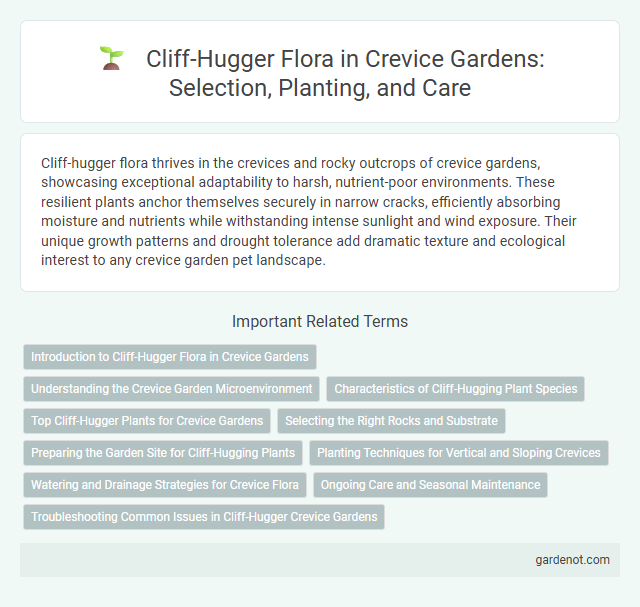Cliff-hugger flora thrives in the crevices and rocky outcrops of crevice gardens, showcasing exceptional adaptability to harsh, nutrient-poor environments. These resilient plants anchor themselves securely in narrow cracks, efficiently absorbing moisture and nutrients while withstanding intense sunlight and wind exposure. Their unique growth patterns and drought tolerance add dramatic texture and ecological interest to any crevice garden pet landscape.
Introduction to Cliff-Hugger Flora in Crevice Gardens
Cliff-hugger flora in crevice gardens thrive by anchoring themselves in narrow rock fissures, where soil is minimal and drainage is exceptional. These specialized plants include alpine saxifrages and miniature succulents that have adapted to withstand harsh conditions such as temperature extremes and limited moisture. Their unique root systems and compact growth forms make them ideal for enhancing vertical surfaces with natural greenery in rock garden designs.
Understanding the Crevice Garden Microenvironment
Cliff-hugger flora thrive in the specialized microenvironment of crevice gardens, where narrow rock fissures create unique conditions of moisture retention and temperature regulation. These plants have adapted to survive with limited soil, minimal nutrients, and intense sunlight exposure, often developing deep root systems to anchor themselves securely. Understanding the intricate balance of water flow, air circulation, and sunlight availability in crevice gardens is essential for cultivating cliff-hugger species successfully.
Characteristics of Cliff-Hugging Plant Species
Cliff-hugging plant species exhibit specialized root systems that anchor firmly into narrow rock crevices, allowing them to thrive in minimal soil conditions. These plants demonstrate remarkable drought tolerance, with thick, waxy leaves or hairy surfaces that reduce water loss and protect against intense sunlight. Their slow growth rates and compact forms minimize exposure to harsh winds, ensuring survival in precarious cliffside environments.
Top Cliff-Hugger Plants for Crevice Gardens
Top cliff-hugger plants for crevice gardens include Sedum rupestre, Sempervivum tectorum, and Saxifraga oppositifolia, which thrive in narrow rock fissures with minimal soil. These species exhibit exceptional drought tolerance and root penetration abilities, making them ideal for stabilizing rocky slopes while providing vibrant blooms and varied textures. Incorporating such flora enhances the ecological diversity and visual appeal of crevice garden environments.
Selecting the Right Rocks and Substrate
Selecting the right rocks and substrate is crucial for establishing a thriving crevice garden that supports cliff-hugger flora such as saxifrages and sedums. Opt for durable, weather-resistant stones like granite or limestone that mimic natural cliff conditions and provide adequate drainage. Incorporate a gritty, well-draining substrate composed of coarse sand, gravel, and organic matter to replicate the sparse soil found in rock crevices, ensuring root stability and moisture retention tailored to alpine and xeric plants.
Preparing the Garden Site for Cliff-Hugging Plants
Selecting a suitable cliff face with ample sunlight and well-drained, rocky soil is essential for preparing the garden site for cliff-hugging plants. Clearing loose debris and creating deep crevices or pockets in the rock surface provides secure planting niches that mimic natural habitats. Incorporating a mix of gritty substrates and organic matter ensures optimal moisture retention and root stability for cliff-hugger flora survival.
Planting Techniques for Vertical and Sloping Crevices
Cliff-hugger flora thrives in vertical and sloping crevices by utilizing specialized planting techniques such as pocketing soil into natural fissures and securing resilient root systems with rock anchors. These plants are selected for their drought tolerance, shallow root structures, and ability to cling to minimal substrate, ensuring stability and moisture retention in precarious environments. Effective planting involves strategic placement that mimics natural growth patterns, optimizing sunlight exposure and wind resistance for enhanced survival on steep, rocky faces.
Watering and Drainage Strategies for Crevice Flora
Crevice gardens featuring cliff-hugger flora require precise watering strategies to mimic natural seepage conditions, ensuring moisture reaches deep root zones without causing waterlogging. Implementing well-draining substrates like gritty sand and gravel facilitates rapid excess water runoff, preventing root rot and fostering optimal aeration. Strategic placement of drip irrigation systems combined with seasonal rainwater harvesting supports sustainable hydration tailored to the unique microclimate of crevice environments.
Ongoing Care and Seasonal Maintenance
Cliff-hugger flora in crevice gardens require consistent watering and monitoring to ensure root systems do not dry out, especially during hot, dry spells. Seasonal maintenance involves removing dead foliage in early spring to promote healthy growth and applying mulch to stabilize soil moisture and temperature. Regular inspections for pests and diseases help maintain plant vitality and prevent spread within the narrow crevices.
Troubleshooting Common Issues in Cliff-Hugger Crevice Gardens
Cliff-hugger flora in crevice gardens often face challenges such as soil erosion, inadequate drainage, and nutrient deficiencies due to their vertical planting environment. Addressing these issues requires using well-draining, nutrient-rich soil mixtures and incorporating organic mulch to retain moisture and prevent root rot. Regular monitoring for pests and adjusting watering schedules can improve plant resilience and support healthy growth in cliff-hugger crevice garden settings.
Cliff-hugger flora Infographic

 gardenot.com
gardenot.com